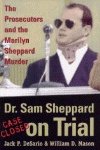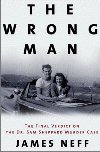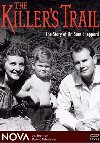Books
Bailey, F. Lee, The Defense Never Rests (1971).
(This book devotes approximately 40 pages to the Sam Sheppard case. It begins with a background of the case, but focused primarily on the second trial when F. Lee Bailey served as Sheppard's attorney. In the book, F. Lee Bailey reveals his strategy in the re-trial. F. Lee Bailey was a pallbearer at Sheppard’s funeral.)

(In this comprehensive reinvestigation of the case, Sam Reese Sheppard and Cynthia Cooper follow a trail of secret contacts, false leads, confessions, tips, and new evidence to unravel mysteries surrounding the case. With the help of a private investigative agency, they delve into original files, recently recovered documents, Sheppard family papers, forensic evidence, and interviews with new witnesses and prime suspects. The book is written from the family’s viewpoint. It includes 328 pages of text, 21 illustrations, 40 pages of endnotes, and a 15-page index.)

(This book is a detailed and passionately argued narrative of the third Sheppard trial, Sam Reese Sheppard's 2003 wrongful imprisonment suit against the State of Ohio. William Mason successfully defended Ohio in the trial and the book is clearly written from Mason's perspective. He attacks the the Richard Eberling- as- the- real- killer theory, paints the picture of an unhappy marriage between Sam and Marilyn, and finds little of significance in recent DNA evidence. The book argues that Sheppard was guilty as charged.)
Holmes, Paul, Retrial: Murder and Dr. Sam Sheppard (1966).
(This is Paul Holmes’ sequel to his 1961 book (below). It suffers from being rushed into print within weeks of the verdict. Only 88 of the 240 pages are devoted to the trial, and 50 of those are transcripts of testimony by Mary Cowen and Dr. Paul Kirk which had already been summarized; apparently they were added to fill the book. This book does not contain an index or notes.)
Holmes, Paul, The Sheppard Murder Case (1961).
Paul Holmes, a reporter for the Chicago Tribune, wrote this bestseller, the first book arguing that Sheppard was wrongfully convicted. Holmes theorizes that two people, a man and a woman, committed the murder. (He seems to suggest, without saying so directly, that Mayor Spencer Houk and his wife Esther were the actual murderers.)
Kilgallen, Dorothy, Murder One (1967).
(This book describes six murder trials the reporter covered, with “When Justice Took the Day Off”--about the Sheppard trial-- as the last and longest chapter. Kilgallen calls the Sheppard trial “the most extraordinary murder trial of the century” and offers her opinion that the decision of the jury was “incomprehensible...I was aghast.”)

Pollack, Jack Harrison, Dr. Sam an American Tragedy (1972).
(New, important facts about Sheppard's life are disclosed in this absorbing biography. The tragic collapse of Dr. Sam is sensitively recounted from the morning of the murder: the suicide of his mother, the premature death of his father, his alienation from his two brothers, his ten-year imprisonment, and his legal failures until F. Lee Bailey represented him before the U.S. Supreme Court and in a retrial. The final tragedy-- Sam’s stint as a professional wrestler, his resort to drugs and liquor, and his death-- are all discussed. The book has 16 pages of photographs and an index. It served as the basis of a 1976 television movie called Guilty or Innocent?)
Seltzer, Louis B., The Years Were Good (1956)(Chapter 26).
(Chapter 26 is devoted to the Seltzer's reasons (Seltzer was the editor of The Cleveland Press) for his series of editorials about the case.)
Sheppard, Sam, Endure and Conquer: My 12-Year Fight for Vindication (1966).
(This is the defendant’s own story, including details from his prison experiences. This book does not contain an index or notes.)
Sheppard, Stephen and Holmes, Paul, My Brother’s Keeper (1964).
(Dr. Steve Sheppard’s account of his family's ordeal caused by Marilyn's murder and Sam's prosecution. The book is less focused on the guilt or innocence of Dr. Sam Sheppard that on what it means to a family to have a member of the family accused and convicted of a murder that other members of the family are convinced that he did not commit. The book describes the family as it deals with defeat after defeat in the legal system, comes to terms with such personal tragedies as the suicide of a mother, and suffers the slings and arrows of a sensational press.)
Thorwald, Jurgen, Crime and Science: The New Frontier in Criminology (1967).
(This book devotes five of its 63 chapters to the Sheppard case and Dr. Kirk’s investigation of the murder. The author maintains that Dr. Gerber was incompetent. The author, a German, gives no indication that he visited the United States in researching the book.)
Video
A & E Television Network, American Justice: "The Sam Sheppard Case" (A & E Home Video) (50 minutes)(1996).
ABC, The Fugitive (1963-1967).
(A television series on ABC starring Dr. Richard Kimball, played by David Jansson. Kimball had been wrongfully convicted of his wife’s murder but escaped and was trying to find the real killer- “the one-armed man.” In the final episode, one of the most-watched television shows ever, Dr. Kimball and the small-town Lieutenant Gerald find the true killer, a one-armed drifter who falls to his death from the top of a carnival ride as they chase him. As the show closes, Dr. Kimball walks away from the courthouse, a free man. He hesitates slightly at the sight of a police car, then nods to say hello and walks on. The message: everything will be fine. The Fugitive was almost universally believed to be based on the Sheppard case, although its creator, Roy Huggins, insisted it wasn’t. When the show was canceled in August of 1967, the New York Times suggested it was because its ratings had fallen following Sheppard’s release. Differences between the show and the Sheppard case include: Kimball’s wife was not pregnant, Sheppard’s was; the Kimballs were arguing the evening of the murder, the Sheppards were not; the Kimballs were infertile, the Sheppards were not.)
Guilty or Innocent? (1975).
(A television docudrama co-starring George Peppard and William Windom. This three-hour show was based on the
book Dr. Sam: An American Tragedy by Jack Harrison Pollack.)
My Father’s Shadow: the Sam Sheppard Story (1998).
(This two-hour movie, shown by CBS, starred Henry Czerny as the adult Sam Reese Sheppard and Peter Strauss as his father, Dr. Sam Sheppard. The film is not a docudrama of the Sheppard murder case and trial, but rather the story of “the lost son who had to find out what really happened.”)

Warner Brothers, The Fugitive (2 hrs., 17 min.)(1993).
(Rated PG-13, starring Harrison Ford as Dr. Richard Kimball, whose character is very loosely based on Sam Sheppard.)
Links
Cleveland State University (Ohio) digital archive of the Sheppard case files
Chapter 1 of Dr. Sheppard's son's book about the case "Mockery of Justice"
Dr. Sam Sheppard ("Biography of a Murder...A Monthly Mystery Magazine")
1999 Discussion of Murder on PBS's Nova
The Media and the Sheppard Trial
Excerpts from Newspaper Accounts and Editorials
CNN Report on 1998 DNA Evidence
Cleveland Plain Dealer Archive
TruTv: Notorious Murders: Most Famous, Sam Sheppard
TruTv: Notorious Murders:Most Famous, "Crime Scene Analysis of the Marilyn Sheppard Murder
TruTv: Notorious Murders:Most Famous, "Dr. Sam Sheppard 50th Anniversary"
